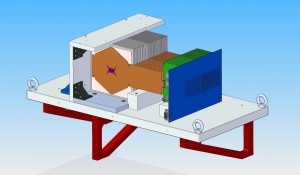
Engineering drawing of the electromagnetic calorimeter at SLAC. This drawing shows the full depth of the ECAL, but unlike the real calorimeter, it is only one sensor wide. The sensor, though not visible in the drawing, is located underneath the hexagonal brown cable. Image courtesy of Marco Oriunno.
Researchers are taking a step towards the realisation of the International Linear Collider’s (ILC) SiD detector with a test beam of a SiD-specific electromagnetic calorimeter (ECAL) planned for this month at SLAC.
This initial test beam could actually be considered a “test” test beam, as this run will utilise a partial calorimeter. Researchers involved in the SLAC, University of Oregon, UC Davis and UC Santa Cruz (US) collaboration hope to identify any early problems with the beam and the calorimeter’s sensors and electronics. They plan to conduct the initial test on 23 July and hope to complete the second “real” run by the end of the year.
“The (initial) beam test is a focus on pulling things together enough to see what the next steps are going to be,” said Marty Breidenbach, SLAC researcher and member of the SiD Executive Committee. “We don’t expect it to be a good calorimeter, but we expect to see what the issues are.”
Work on this silicon-tungsten ECAL began prior to the selection of the ILC design in 2004, when SLAC was still working toward its Next Linear Collider design. Major steps along the way have involved developing the current sensors, which convert the energy of particles into electronic signals, and the readout electronics, which process these signals.
The current SLAC ECAL system is a prototype for the ECAL needed for SiD, one of the ILC’s two proposed detectors. Both detectors will use an algorithm called particle flow to identify and measure the energy of the jets of particles formed when the electrons and positrons collide in the ILC. The role of the ECAL system is to measure the energy and direction of certain particles – photons, electrons and positrons – as they hit the calorimeter. To do this, the ECAL must have very high spatial resolution and good energy resolution to distinguish the location and energy of different particles.
For the SLAC ECAL, achieving this high resolution while remaining compact and cost-effective involves several innovative features. Two of these features are the small pixel size of the sensors and the small gaps between the calorimeter’s tungsten plates, where the sensors are located. Each of the calorimeter’s sensors has 1024 pixels, and the gaps in the test calorimeter are only 1.25 millimetres wide, though researchers hope to reduce them to 1 millimetre. Keeping the pixel size and the gaps small allows the particles depositing energy in the calorimeter to be more easily distinguished from one another.
In addition, the ECAL’s readout electronic chips are attached directly to the sensors, a setup that saves space by removing the need for bulky signal cables.
Connecting these electronic chips to the sensors through a method known as bump bonding has been one of the recent challenges in the preparation of the calorimeter for the test beam. In fact, this challenge is one reason the calorimeter will be only partially assembled at the time of the first test, having only 12 of the 31 sensors that it will ultimately include.
In addition to testing the function of the beam and electronics, the researchers plan to use the initial test beam to evaluate the calorimeter’s signal-to-noise ratio.
“These are very small signals that we deal with,” said Breidenbach. “We have to see if everything can work at this low level.”
The initial test will take place in SLAC’s End Station A, with 5 pulses per second of beam taken from SLAC’s Linac Coherent Light Source (LCLS) laser.
This End Station A Test Beam will provide a beam of particles similar to that which would emerge from the ILC interaction region, where the electrons and positrons collide. The test beam can function in two modes, for use in developing both detector and accelerator components. Like the beam coming from the interaction region, the mode that will be used includes only a few particles per pulse.
“It’s difficult to test (this calorimeter) with other test beams,” Breidenbach said, referring to beams that would provide a continuous stream of particles rather than the ILC-type pulses. “The ECAL electronics have been very much optimised for the ILC.”
After the July test, the researchers will finish adding the remaining sensors and make adjustments to the ECAL.
“For the real run, then, we’ll be interested in measuring calorimeter performance,” Breidenbach said. These measurements include uniformity of the signal across a sensor, as well as spatial resolution and energy resolution.
“I think it’s a necessary demonstration for SiD,” Breidenbach said of the test beams.

Recent Comments